Drafts by Mary Ann Harlan
In 2017 two books that explicitly explored rape culture in high schools were published, Moxie by ... more In 2017 two books that explicitly explored rape culture in high schools were published, Moxie by Jennifer Mathieu and The Nowhere Girls by Amy Reed. Neither book centered a rape, and yet both books addressed sexual assault, harassment, and the culture that girls experience in schools.
This paper examines the themes at the core of how the objectification of girls as good girls, mean girls, sluts, virgins, and jezebels perpetuates rape culture and the patriarchy, silencing girls. This reduces the capacity of girls to be subjects in their own lives. It creates a structure in which girls are both sexualized and supposed to refrain from sex, objects in how society constructs girl as a concept. This creates a culture emphasizes sexual activity, or lack thereof, in defining what a girl is, and how a girl should be.
Papers by Mary Ann Harlan
Berghahn Books, Dec 31, 2022
She earned her PhD in 2012 completing research that focused on information practices of teen cont... more She earned her PhD in 2012 completing research that focused on information practices of teen content creators. Since that time she has been researching representations of girlhood in popular texts, particularly Young Adult literature. Her current research investigates how teens understand fiction as an information source, and the practices they engage in while reading fiction that uses information to learn. She also is the Teacher Librarian Program Coordinator, having spent 10 years in school libraries in California.

School of Information Student Research Journal, Jun 15, 2019
Information literacy, the ability to effectively seek, evaluate, and use information, is a concer... more Information literacy, the ability to effectively seek, evaluate, and use information, is a concern of library science and instruction as evidenced by a variety of evolving standards from professional organizations (American Library Association, 2018; Association of College & Research Libraries (ACRL), 2016). A close look at these standards reveals an assumption that information is fact based, and information literacy is an academic skill. This makes sense as the mission of organizations such as ACRL and AASL is to support librarians in teaching at both the higher education and K12 levels . Research in information literacy, as well as information behaviors and information practices, however, has developed a broader understanding of information-one might say they position information as anything that is informing . Furthermore, everyday life information seeking and information behavior research extends the notion of information sources including the people around us, media we encounter, and all manner of less academic sources. Recently I have begun to ask how non-informational texts or aesthetic texts, in other words, fiction, work as an information source. Do we read fiction to learn? Are stories a way to learn about ourselves and the world and in what ways might they be? Current conversations including #ownvoices, #weneeddiversebooks, and a reemergence of Rudine Sims Bishop's 1990 article on books as windows, mirrors and sliding glass doors assume that fiction is a source of information. While these conversations occur in multiple communities, they dominate conversations in the young adult literature world. The basic premise is that reading fiction can tell us something about our world and/or ourselves within the world when we engage with story. I think this is an assumption worth investigating. However, for the purposes of this article I accept the belief that there is some truth to the idea that we read fiction to learn about ourselves and our world. Based on this assumption, critical reading requires us to examine fiction as information source in terms of what constructions are presented in the stories, as representation has many facets, and the information in stories can both perpetuate and/or challenge social norms and expectations. In the humanities, specifically literary criticism, there has been a consistent call for critics to apply the same rigor of critique to literature classified as young adult as there is for other literary categories . However, within the Educational and Library and Information Science fields the focus of research has been primarily on the reader and/or literacy programs including classroom reading pedagogies. I often read the argument in both the professional and research literature that the 1 Harlan: Challenging Girlhood

What are the information practices of teen content creators? In the United States over two thirds... more What are the information practices of teen content creators? In the United States over two thirds of teens have participated in creating and sharing content in online communities that are developed for the purpose of allowing users to be producers of content. This study investigates how teens participating in digital participatory communities find and use information as well as how they experience the information. From this investigation emerged a model of their information practices while creating and sharing content such as film-making, visual art work, story telling, music, programming, and web site design in digital participatory communities. The research uses grounded theory methodology in a social constructionist framework to investigate the research problem: what are the information practices of teen content creators? Data was gathered through semi-structured interviews and observation of teen’s digital communities. Analysis occurred concurrently with data collection, and the...

School Libraries Worldwide, 2016
IntroductionLearning is a daily activity embedded in our life world; it is not limited to the hou... more IntroductionLearning is a daily activity embedded in our life world; it is not limited to the hours spent in a classroom. We engage in our world in different ways, and in doing so encounter information that we question, assimilate, and use to confirm what we know. This requires one to make connections between new information and existing knowledge. Therefore, learning is in a word-connected. When we engage with information we connect to ourselves, our understandings, our experiences, as well as with others and to the world around us.The initial research question focused on information literacy skills needed by teens' in a Web 2.0 environment. As the initial study used grounded theory as a methodology, interviews suggested a need for a different framework to truly understand teen content creators' experiences. The emergent research question was: what are the information practices of teen content creators? As I was engaged in data collection and analysis, the connected learnin...
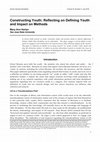
School Libraries Worldwide, 2016
Introduction \ chool libraries serve both the youth - the students who attend the school, and adu... more Introduction \ chool libraries serve both the youth - the students who attend the school, and adults - the teachers who work there. Research on issues that impact school libraries therefore can focus on a variety of contexts, including the school librarian, the teachers, the resources, and the students. This paper addresses specifically issues regarding research that focuses on youth, and at its core is a reflection on whether we are doing research "on" youth, or rather "with" youth, and why this distinction matters. I explore the issues that impact research involving youth participants by making use of my research experience with youth information practices and trans disciplinary arguments regarding how we construct youth as a category, how memory impacts both our definition of youth and our research design, and how power structures can influence data collection and analysis.LIS as a Transdisciplinary FieldOne of the strengths of library and information science ...

Most school librarians are solo librarians working with little direct contact with their counterp... more Most school librarians are solo librarians working with little direct contact with their counterparts in schools or in other types of libraries. This makes it very difficult to keep up with trends and issues. Building a personal learning network will help overcome the isolation. Most school librarians are solo librarians working away from little direct contact with their counterparts in schools and in other types of libraries. Sometimes this is geography and other times it is the lack of opportunities within their school districts or communities to become acquainted and communicate. It is very difficult to keep up with trends and issues, new methods or activities that should be tried in libraries. For those who did not learn the importance of professional development in their education programs, the author discusses the need for the solo librarian to remain current and to continue to find ways to use in continuing advocacy for their school library programs. Building a personal learn...
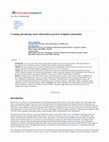
Inf. Res., 2014
Introduction In a connected world youth are participating in digital content creating communities... more Introduction In a connected world youth are participating in digital content creating communities. This paper introduces a description of teens' information practices in digital content creating and sharing communities. Method The research design was a constructivist grounded theory methodology. Seventeen interviews with eleven teens were collected and observation of their digital communities occurred over a two-year period. Analysis The data were analysed iteratively to describe teens' interactions with information through open and then focused coding. Emergent categories were shared with participants to confirm conceptual categories. Focused coding provided connections between conceptual categories resulting in the theory, which was also shared with participants for feedback. Results The paper posits a substantive theory of teens' information practices as they create and share content. It highlights that teens engage in the information actions of accessing, evaluating,...

School Libraries Worldwide, 2016
This paper explores the research literature relevant to the increasingly popular field of Inquiry... more This paper explores the research literature relevant to the increasingly popular field of Inquiry Based Learning (IBL) practices in K-12 academic environments. IBL is constructivist and student-centered (Barron & Darling-Hammond, 2008; Condliffe, Visher, Bangser, Drohojowska & Saco 2016; Duffy & Raymer, 2010; Kuhlthau, Maniotes, & Caspari, 2015), leveraging student motivation and engagement through its grounding in authentic, relevant study (Deci & Ryan, 2016; SaundersStewart, Gyles, Shore & Bracewell, 2015). Recent research shows positive academic and achievement gains for students engaged in IBL work and the practice is growing. Some educators are experimenting with variations of increasingly student-driven models that privilege student choice and autonomy, such as 20% time or genius hour (Krebs & Zvi, 2015), passion-based learning (Maiers & Sandvold, 2010), and personalized learning (Bray & McClaskey, 2016). We name these more student-autonomous frameworks Student Driven Inquiry ...

What are the information practices of teen content creators? In the United States over two thirds... more What are the information practices of teen content creators? In the United States over two thirds of teens have participated in creating and sharing content in online communities that are developed for the purpose of allowing users to be producers of content. This study investigates how teens participating in digital participatory communities find and use information as well as how they experience the information. From this investigation emerged a model of their information practices while creating and sharing content such as film-making, visual art work, story telling, music, programming, and web site design in digital participatory communities. The research uses grounded theory methodology in a social constructionist framework to investigate the research problem: what are the information practices of teen content creators? Data was gathered through semi-structured interviews and observation of teen’s digital communities. Analysis occurred concurrently with data collection, and the...

IASL Annual Conference Proceedings
Information Literacy is built on the idea that when we encounter information we can evaluate that... more Information Literacy is built on the idea that when we encounter information we can evaluate that information to incorporate into our knowledge schema. As such information can be encountered in a variety of ways, as academic information, workplace information, or everyday life information. Art forms can also be considered information, including literature. As an art form literature has been theorized to be a window, mirror, and a sliding glass door (Bishop, 1990) to the reader, an information source regarding our world. The notion that fiction is an information source is not particularly considered in much of the information literacy scholarly research. This paper examines how adolescents engage with fiction as a source of information. Using a small case study of a class of 16 and 17 year olds the paper examines how they construct ficiton and aesthetic reading as an information source, particularly using the metaphor of the window and the mirror. While students might consider re...
Faculty of Science and Technology Information Systems, 2012
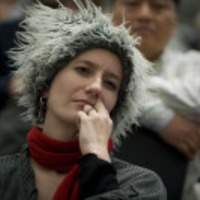
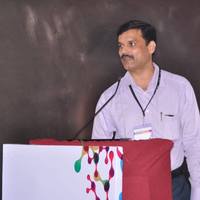

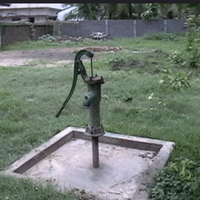



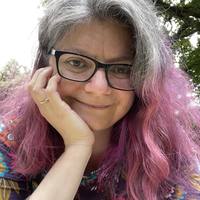

Uploads
Drafts by Mary Ann Harlan
This paper examines the themes at the core of how the objectification of girls as good girls, mean girls, sluts, virgins, and jezebels perpetuates rape culture and the patriarchy, silencing girls. This reduces the capacity of girls to be subjects in their own lives. It creates a structure in which girls are both sexualized and supposed to refrain from sex, objects in how society constructs girl as a concept. This creates a culture emphasizes sexual activity, or lack thereof, in defining what a girl is, and how a girl should be.
Papers by Mary Ann Harlan
This paper examines the themes at the core of how the objectification of girls as good girls, mean girls, sluts, virgins, and jezebels perpetuates rape culture and the patriarchy, silencing girls. This reduces the capacity of girls to be subjects in their own lives. It creates a structure in which girls are both sexualized and supposed to refrain from sex, objects in how society constructs girl as a concept. This creates a culture emphasizes sexual activity, or lack thereof, in defining what a girl is, and how a girl should be.
Young Adult literature is often defined with terms such as “coming of age” and with references to “becoming” (Alsop, 2016). As such it addresses a myriad of issues related to youth experience. This paper focuses representations of the sexual experiences of girls in young adult literature published in the last five years. In YA literature exploration of sexual desires and actions can be risky, often books that explore these topics are challenged as ‘inappropriate’ or ‘pornography’ (American Library Association, 2016). However in the YA romance genre growing up and sex is inextricably linked (Younger, 2013) and it is this genre that is primarily explored in this paper. Using a feminist standpoint this presentation addresses three specific narratives found in representative titles. The narratives related to girl’s desire are the importance and loss of virginity, the labeling of sexually active girls, and the risk of sexual assault. Analysis attempts to describe these three discourses in relation to existing postfeminist discourse and clarify how young adult literature reinforces and challenges cultural constructions of girl’s and desire in relation to sexual experiences.